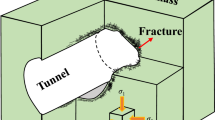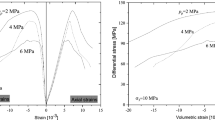Abstract
It is widely acknowledged that the natural rock mass is anisotropic and its failing type is also non-isotropic. An orthotropic elastic damaged model has been proposed in which the elastic deformation, the damaged deformation and irreversible deformation can be identified respectively. A second rank damage tensor is employed to characterize the induced damage and damage evolution related to the propagation conditions of microcracks. A specific form of the Gibbs free energy function is used to obtain the effective elastic stiffness and the limited scopes of damage parameters are suggested. The model’s parameter determination is proposed by virtue of conventional tri-axial test. Then, the proposed model is developed to simulate the coupled hydraulic mechanical responses and traction behaviors in different loading paths of porous media.
Similar content being viewed by others
References
Al-Rub R K A, Voyiadjis G Z. Gradient-enhanced coupled plasticity-anisotropic damage model for concrete fracture: Computational aspects and applications. Int J Damage Mech, 2009, 18: 115–154
Basista M, Weglewski W. Chemically assisted damage of concrete: A model of expansion under external sulfate attack. Int J Damage Mech, 2009, 18: 155–176
Cheng A H D. Material coefficients of anisotropic poro-elasticity. Int J Rock Mech Min Sci, 1997, 34: 199–205
Chen Z B, Jiang X, Zhou Z, et al. Progress in application of CFD techniques. Sci China Ser E-Tech Sci, 2008, 51: 827–841
Costin L S. A microcrack model for the determination and failure of brittle rock. J Geophy Res, 1983, 88: 9485–9492
Costin L S. Damage mechanics in the post failure regime. Mech Mater, 1985, 4: 149–160
Desmorat R, Cantournet S. Modeling microdefects closure effect with isotropic/anisotropic damage. Int J Damage Mech, 2008, 17: 65–96
Pickering D J. Anisotropic elastic parameters for soil. Géotech, 1970, 20: 271–276
Lydzba D, Shao J F. Study of poro-elasticity material coefficients as response of microstructure. Mech Cohesive-frictional Mater, 2000, 5: 149–171
Dragon A, Charlez P, Pham D, et al. Anisotropic Damage Model for Brittle Rock, in Assessment and Prevention of Failure Phenomena in Rock Engineering. Balkema, 1993. 71-78
Grammenoudis P, Reckwerth D, Tsakmakis Ch. Continuum damage models based on energy equivalence: Part I-isotropic material response. Int J Damage Mech, 2009, 18: 31–64
Grammenoudis P, Reckwerth D, Tsakmakis Ch. Continuum damage models based on energy equivalence: Part II-anisotropic material response. Int J Damage Mech, 2009, 18: 65–91
Halm D, Dragon A. A model of anisotropic damage by meso-crack growth, unilateral effect. Int J Damage Mech, 1996, 5: 384–402
Shao J F. Poro-elastic behaviour of brittle rock materials with anisotropic damage. Mech Mater, 1998, 30: 41–53
Shao J F, Rudnicki J W. A microcrack-based continuous damage model for brittle. Geo-mate, 2000, 36: 52–63
Berryman J G. Effective medium approximation for elastic constants of porous solids with microscopic heterogeneity. J Appl Phys, 1986, 59: 1136–1140
Auriault J L, Boutin C. Deformable media with double porosity quasistatic II: Coupling effects. Transp Porous Media, 1990, 10: 153–169
Ju J W. On the energy based coupled elastoplastic damage theories: Constitutive modelling and computational aspects. Int J Solids Struc, 1989, 25: 803–833
Kachanov M. Elastic solids with many cracks and related problems. Adv Appl Mech, 1993, 30: 259–445
Kachanov M. Effective elastic properties of cracked solid: Critical review of some basic concepts. ASME, Appl Mech Rev, 1992, 45: 304–335
Kemeny J M. A model for nonlinear rock deformation under compression due to subcritical crack growth. Int J Rock Mech Min Sci, 1991, 28: 459–467
Khan A R, Al-Gadhib A H, Baluch M H. Elasto-damge model for high strength concrete subjected to multiaxial loading. J Mater Mech, 2007, 16: 361–398
Krajcinovic D, Fonseka G U. The continuous damage theory of brittle materials. J Appl Mech, 1981, 48: 809–815
Kamiya M S. Constitutive and damage evolution equations of elastic-brittle materials based on irreversible thermodynamics. Int J Mech Sci, 1997, 39: 473–486
Nemat-Nasser S, Horii H. Micro-mechanics: Overall properties of heterogeneous materials. Amsterdam, 1993
Ortiz M. A constitutive theory for the inelastic behavior of concrete. Mech Mater, 1985, 4: 67–93
Shirzly A, Tirosh J, Rubinski L. Densification process of porous materials under uniaxial compression. J Appl Mech, 2007, 16: 427–456
Yu S W, Feng X Q. A micromechanics-based damage model for microcrack-weakened brittle solids. Mech Mater, 1995, 20: 59–76
Swoboda G, Yang Q. An energy-based damage model of geomaterials-I. Deduction of damage evolution laws. Int J Solids Struct, 1999, 36: 1735–1755
Swoboda G, Yang Q. An energy-based damage model of geomaterials-I. Deduction of damage evolution laws. Int J Solids Struct, 1999, 36: 1735–1755
Thakkar B K, Panley P C A. High-order isotropic continuum damage evolution model. J Mater Mech, 2007, 16: 403–426
Yang Q, Swoboda G, Zhao D, et al. Damage Mechanics of Jointed Rock in Tunneling. New York: Springer, 2003. 117–160
Yazdani S, Schreyer H L. An anisotropic damage model with dilatation for concrete. Mech Mater, 1988, 7: 231–244
Lu Y F, Shao J F. Modelling of anisotropic damage in brittle rocks under compression dominated stresses. Int J Numer Anal Meth Geomech, 2002, 26: 230–247
Zhang J, Liang N G, Deng S C, et al. Study for the damage-induced anisotropy of quasi-brittle materials using the component assembling model. Int J Damage Mech, 2008, 17: 197–222
Author information
Authors and Affiliations
Corresponding author
Rights and permissions
About this article
Cite this article
Lu, Y., Wu, X. & Shao, J. Anisotropic damage coupled modeling of saturated porous rock. Sci. China Technol. Sci. 53, 2681–2690 (2010). https://doi.org/10.1007/s11431-010-4083-4
Received:
Accepted:
Published:
Issue Date:
DOI: https://doi.org/10.1007/s11431-010-4083-4




